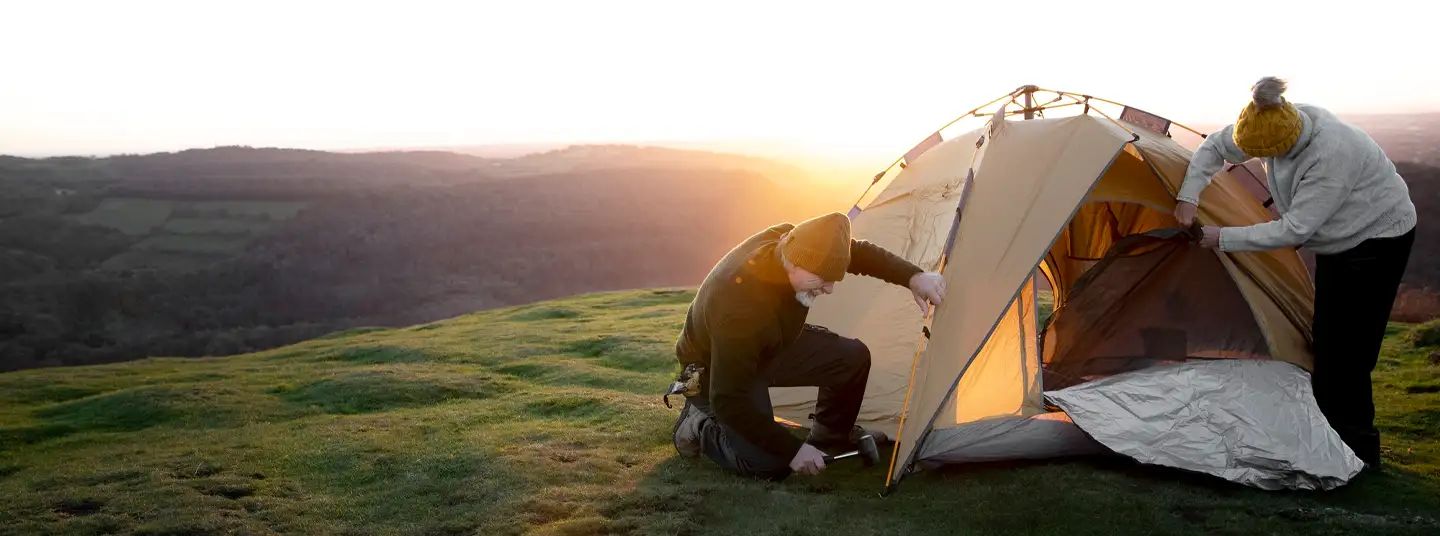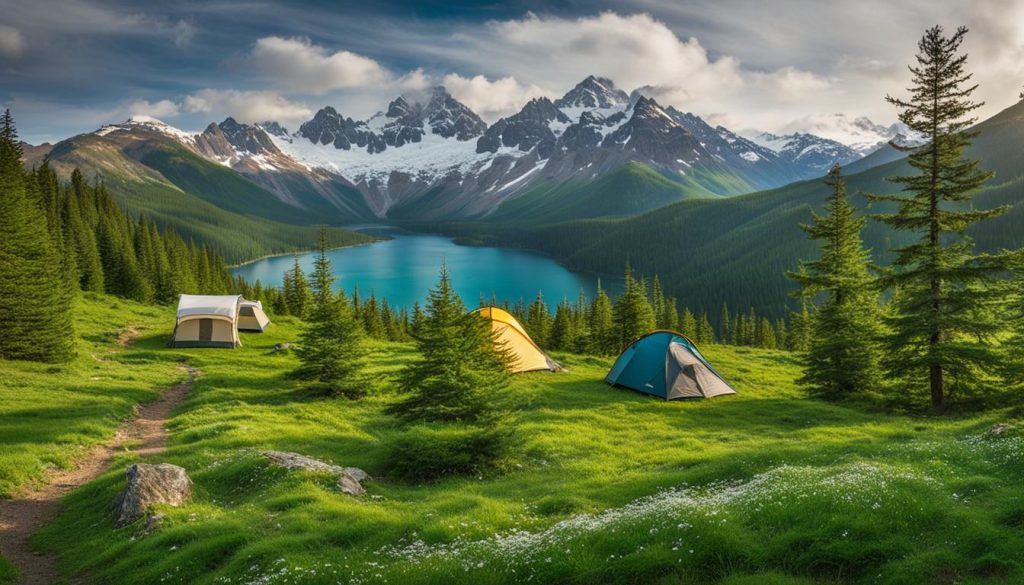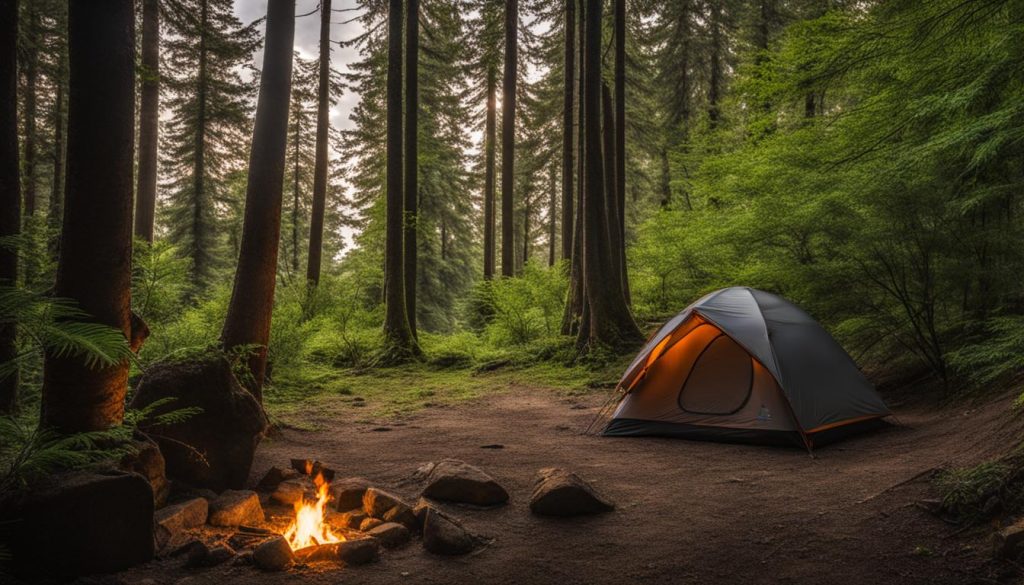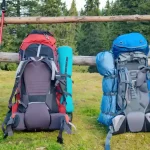

When it comes to planning a spring camping trip, one of the most important decisions we need to make is choosing the right campsite. The location and suitability of our campsite can significantly impact our overall camping experience. To ensure a successful and enjoyable adventure, it’s crucial to consider various factors when selecting a spring campsite.
First and foremost, we need to find campsites that are suitable for the spring season. Areas with temperate climates, beautiful landscapes, and abundant flora and fauna are among the best spring camping destinations. By selecting the right campsites, we can maximize our enjoyment of the vibrant spring season.
It’s also important to gather spring campsite selection tips and recommendations from fellow outdoor enthusiasts, camping forums, or reputable camping guidebooks. Their firsthand experiences and insights can help us discover top spring campsites and ideal spring camping spots that we might not have considered.
Factors such as proximity to water sources and tent orientation are also crucial when choosing a spring campsite. Being able to easily access and enjoy clean water is essential for a comfortable camping experience. Additionally, the direction in which our tents face can protect us from the elements and make our stay more enjoyable.
Lastly, we must always prioritize minimizing our impact on wildlife and the environment. Choosing campsites that have minimal impact on the local ecosystem and following clean campsite practices will help preserve the natural beauty of these areas for future generations.
Key Takeaways:
- Consider the suitability of campsites for the spring season by choosing areas with temperate climates and abundant natural beauty.
- Seek tips and recommendations from fellow outdoor enthusiasts to find the top spring campsites and ideal spring camping spots.
- Ensure proximity to water sources for easy access to clean water during your camping trip.
- Pay attention to tent orientation to shield yourself from the elements and enhance your camping experience.
- Minimize your impact on wildlife and the environment by choosing campsites that have minimal ecological footprint and following clean campsite practices.
Understanding Backcountry Regulations for Spring Camping
Before embarking on a spring camping trip, it is essential to familiarize yourself with the backcountry regulations specific to your chosen destination. Understanding these regulations will ensure that you have a safe and enjoyable camping experience while respecting the wilderness.
Check for Area-Specific Campsite Availability
When planning your spring camping trip, it’s important to check for campsite availability in the areas you wish to visit. Some popular camping spots may require advanced reservations or have limited campsites. By checking for availability ahead of time, you can secure a campsite that suits your needs and preferences.
Importance of Reserving Your Campsite in Advance
Reserving your campsite in advance is crucial, especially during the spring season when campgrounds can quickly fill up. By reserving your campsite ahead of time, you can guarantee a spot and avoid disappointment upon arrival. Many campgrounds offer online reservation systems, making it convenient to secure your campsite well in advance.
Abiding by Wilderness Area Rules
When camping in wilderness areas, it is important to abide by the rules and regulations set in place. These rules are designed to protect the natural environment and ensure the safety of campers. They may include guidelines for campfires, waste disposal, wildlife interaction, and other specific regulations. By following these rules, you can help preserve the beauty of the wilderness and maintain a harmonious coexistence with nature.
Strategies for a Stress-Free Spring Campsite Setup
When it comes to setting up your spring campsite, having the right strategies in place can make the process stress-free and enjoyable. From timing your arrival to selecting impact-reduced areas for camping, there are several key considerations to keep in mind.
Timing Your Arrival to Avoid Twilight Setups
Timing is everything when it comes to setting up your campsite. Arriving before twilight hours can significantly reduce the stress and challenges associated with setting up camp in low light conditions. By planning your arrival earlier in the day, you’ll have ample time to unpack, pitch your tent, and gather firewood before sunset. This allows you to start your camping adventure on a positive note, without feeling rushed or overwhelmed.
Selecting Impact-Reduced Areas for Camping
Preserving the natural surroundings of your campsite is essential for a sustainable outdoor experience. When choosing a campsite, consider areas that have minimal impact on the environment. Look for designated camping spots and avoid setting up your campsite in pristine or fragile areas. By camping in impact-reduced areas, you can minimize your ecological footprint and help preserve the integrity of the wilderness.
By implementing these strategies for a stress-free spring campsite setup, you can create a welcoming and organized camping environment. Remember to plan your arrival time to avoid twilight setups and select impact-reduced areas for camping to have a positive impact on the natural surroundings. With these strategies in place, you’ll be well-prepared to enjoy a seamless and memorable spring camping adventure.
Choosing the Right Spring Campsite, Selecting Campsites Suitable for Spring
When planning a spring camping trip, it is crucial to choose the right campsite that is suitable for the season. Consider various factors to ensure an enjoyable and comfortable camping experience.
One important consideration is the terrain of the campsite. Look for campsites with a terrain that suits your preferences and needs. Whether you prefer a flat surface for easy setup or a more rugged terrain for an adventurous experience, selecting a campsite with the right terrain is essential.
Elevation is another crucial factor to consider. Different areas may have varying elevation levels, which can significantly impact the weather and temperatures. Research the elevation of potential campsites and choose one that aligns with your desired climate for a pleasant spring camping experience.
Accessibility is also an important consideration. Determine how easily you can reach the campsite and whether it requires any special permits or arrangements. Consider factors such as distance from parking areas, trails, and other amenities to ensure convenient access.
Weather patterns during the spring season can be unpredictable. It is important to choose a campsite that is not prone to severe weather conditions such as heavy rainfall or strong winds. Checking weather forecasts and selecting a campsite with a history of favorable spring weather can help you avoid unexpected challenges during your camping trip.

| Campsite | Terrain | Elevation | Accessibility | Weather |
|---|---|---|---|---|
| Pine Creek Campground | Flat and grassy | 300 ft above sea level | Easy access from parking area | Mild spring weather with occasional showers |
| Mountain View Campsite | Rugged and hilly | 1,500 ft above sea level | Moderate hike from trailhead | Slightly cooler temperatures with occasional strong winds |
| Riverfront Campground | Sandy and near water | 50 ft above sea level | Accessible by car | Warmer temperatures with occasional rainfall |
By considering these factors and conducting thorough research, you can choose the right campsite that aligns with your preferences and provides the ideal setting for your spring camping adventure.
Evaluating Proximity and Access to Water at Campsites
When choosing a spring campsite, one crucial aspect to consider is the proximity and access to water. Having convenient access to water is essential for various camping activities such as cooking, cleaning, and drinking. However, it is equally important to balance this convenience with conservation efforts to protect the environment.
The Balancing Act Between Convenience and Conservation
While it is tempting to choose a campsite right next to a water source for easy access, it is important to evaluate the impact it may have on the surrounding ecosystem. Camping near water may disrupt the natural habitat and wildlife that depend on it. It may also result in increased erosion and damage to the vegetation.
When evaluating the proximity and access to water at campsites, it is crucial to consider the following:
- Conservation Efforts: Choose a campsite that is at a reasonable distance from the water source to minimize your impact on the ecosystem. This allows wildlife to access their natural habitat undisturbed.
- Leave No Trace: Follow Leave No Trace principles by properly disposing of waste and avoiding activities that may pollute the water source.
- Water Treatment: If the campsite’s water source is questionable, bring water purification methods or filters to ensure safe drinking water.
Anticipating the Downsides of Water-Adjacent Sites
While camping near water may offer certain advantages, it is essential to anticipate and consider the downsides as well. Here are some potential challenges you may encounter when camping adjacent to water:
- Insect Activity: Water sources attract insects, including mosquitoes and flies. Camping near water may result in increased insect activity and potential discomfort.
- Humidity: Water bodies can increase humidity levels in the surrounding area, making the campsite feel damp and potentially affecting sleeping and comfort.
- Noise: Water sources can generate significant noise, especially if there are rushing streams or waterfalls nearby. This may disturb sleep or quiet moments in camp.
By considering these downsides, you can make an informed decision about whether camping near water is the best choice for your spring camping adventure.
| Advantages of Camping Near Water | Disadvantages of Camping Near Water |
|---|---|
|
|
Ultimately, the decision to camp near water should be based on a balance between convenience and conservation. Consider the specific conditions of the campsite, the impact on the environment, and your own comfort preferences. By evaluating these factors, you can select a campsite that provides a balance between accessibility to water and responsible camping practices.
Selecting Your Tent Orientation and Shielding Yourself from the Elements
The orientation of your tent is crucial in ensuring a comfortable camping experience and shielding yourself from the elements. By strategically positioning your tent, you can minimize exposure to wind, rain, and other weather conditions. Additionally, utilizing natural windbreaks can provide an added layer of protection and enhance your restful sleep.
Utilizing Natural Windbreaks for a Comfortable Rest
When setting up your campsite, look for natural windbreaks such as trees, rocks, or hills that can provide shelter from strong gusts of wind. Position your tent in such a way that these natural structures act as barriers, reducing the impact of wind on your tent. This will help create a more comfortable and peaceful sleeping environment.
Maximizing Morning Sunlight for an Early Start
In addition to shielding yourself from the elements, maximizing morning sunlight can set the tone for a productive and energized day on your camping adventure. When selecting your tent orientation, consider positioning it in a way that allows for maximum exposure to the early morning sunlight. This not only helps warm up your tent but also provides ample natural light to start your day.
By selecting the right tent orientation, utilizing natural windbreaks, and maximizing morning sunlight, you can enhance your camping experience and make the most of your spring adventure.
Minimizing Your Impact on Wildlife and the Environment
As responsible campers, it is crucial to minimize our impact on wildlife and the environment. By adopting sustainable practices, we can preserve the natural habitat and leave a minimal ecological footprint during our spring camping adventures.
The Significance of Camping Beyond the Obvious Tide Line
When camping on the coast, it’s important to consider the impact of tides on the delicate ecosystem. Camping beyond the obvious tide line helps protect coastal habitats and minimize disturbance to wildlife. By setting up camp away from the tide line, we can preserve the nesting sites of shorebirds, dunes, and other sensitive coastal areas.
Respecting Plant Life and Keeping Beaches Clean
While enjoying the beach, it’s essential to respect plant life and keep the surroundings clean. Avoid damaging or uprooting plants, as they play a crucial role in maintaining the coastal ecosystem. Additionally, make sure to properly dispose of all waste and refrain from littering. Keeping beaches clean not only preserves the beauty of the environment but also ensures the safety and well-being of marine life.

| Benefits of Minimizing Impact | Actions to Take |
|---|---|
| Preservation of wildlife habitat | Camp beyond the tide line |
| Conservation of coastal ecosystems | Respect plant life |
| Reduction of litter and pollution | Keep beaches clean |
| Protection of nesting sites for shorebirds | Dispose of waste properly |
By following these practices and being mindful of our actions, we can make a positive impact on the environment and contribute to the long-term sustainability of the natural world we treasure.
Considerations for Camping Comfort and Animal Encounters
When planning a spring camping trip, it’s important to prioritize camping comfort and take necessary precautions for any potential animal encounters. By focusing on these aspects, we can ensure a safe and enjoyable camping experience.
First and foremost, selecting appropriate camping gear is essential for camping comfort. Invest in high-quality tents, sleeping bags, and camping chairs that provide the necessary comfort and support. This will help you relax and recharge after a day of outdoor adventures.
Creating comfortable sleeping arrangements is also crucial. Consider using sleeping pads or inflatable mattresses to cushion the ground and provide a more restful sleep. Additionally, bring warm blankets and pillows to enhance your comfort during chilly spring nights.
To prevent animal encounters, it’s important to take precautions. Store your food properly in bear-proof containers or hang it from a tree branch away from your sleeping area. Keep a safe distance from wildlife and avoid feeding them, as this can disrupt their natural behavior and can be dangerous for both you and the animals.
Remember to properly dispose of any food waste and trash to prevent attracting wildlife to your campsite. Keep your campsite clean and organized to minimize the risk of unwanted visitors. By practicing responsible wildlife interactions, we can help protect both ourselves and the animals.
In conclusion, when planning a spring camping trip, always prioritize camping comfort and take precautions to prevent animal encounters. By selecting appropriate gear, creating comfortable sleeping arrangements, and practicing responsible wildlife interactions, we can ensure a safe and enjoyable camping experience.
Navigating the Challenges of Spring Weather and Topography
When camping during the spring season, campers often encounter unique challenges posed by the weather and topography. It is crucial to be aware of these challenges and take necessary precautions to ensure a safe and enjoyable outdoor adventure.
Avoiding Areas Prone to Avalanches or Heavy Snow
Spring weather can be unpredictable, with the potential for avalanches and heavy snowfall in certain areas. It is essential to research and avoid camping in locations known for avalanche-prone terrain or areas with heavy snow accumulation. By staying away from these hazardous areas, you can minimize the risk of accidents and ensure your safety.
Utilizing Snow for Minimal Environmental Impact
While navigating the challenges of spring weather and topography, campers can utilize snow to their advantage while minimizing their environmental impact. Freezing temperatures and snow accumulation can provide opportunities for recreational activities such as snowshoeing, cross-country skiing, and building snow shelters. By making use of the available snow resources, campers can reduce their reliance on other materials and minimize their ecological footprint.
Our approach is centered around sustainability and responsible outdoor practices. Utilizing snow not only adds an element of fun to your camping experience but also aligns with minimizing environmental impact.
A visually appealing image showcases campers building a snow shelter, representing the use of snow during spring camping for minimal environmental impact.
| Challenges of Spring Weather and Topography | Recommendations |
|---|---|
| Avalanche-prone areas | Avoid camping in locations prone to avalanches or heavy snowfall |
| Heavy snowfall | Stay informed about local weather forecasts and avoid camping in areas with heavy snow accumulation |
| Utilizing snow | Engage in snow-related activities such as snowshoeing, cross-country skiing, and building snow shelters |
| Environmental impact | Minimize your ecological footprint by utilizing snow resources instead of relying on other materials |
The table provides a summary of the challenges posed by spring weather and topography, along with corresponding recommendations for campers to overcome these challenges. It visually organizes the information and enables readers to quickly grasp the key points.
Conclusion
In conclusion, selecting the right campsite is crucial for an enjoyable and responsible spring camping experience. By following the tips and strategies outlined in this article, such as practicing clean campsite practices and making the most of your spring camping adventure, you can ensure a memorable and sustainable outdoor experience.
Leaving No Trace with Clean Campsite Practices
One of the most important principles to follow while camping is to leave no trace. This means leaving the campsite in the same condition as you found it, without any evidence of your presence. To achieve this, make sure to pack out all trash and waste, properly dispose of any fire remains, and avoid damaging vegetation or natural features. By adopting these clean campsite practices, we can preserve the beauty of our natural surroundings and minimize our impact on the environment.
Making the Most of Your Spring Camping Adventure
Spring camping offers a wonderful opportunity to reconnect with nature and create lasting memories. To make the most of your adventure, take the time to immerse yourself in the surroundings, appreciate the beauty of the flora and fauna, and participate in outdoor activities like hiking, fishing, or wildlife spotting. Remember to be prepared for changing weather conditions, pack appropriate gear, and always prioritize safety. By fully embracing the experience, you can create cherished moments and forge a deeper connection with the great outdoors.
So, as you embark on your spring camping trip, remember to leave no trace and practice clean campsite etiquette. By doing so, you not only ensure the preservation of our natural environment but also contribute to the enjoyment of future campers. Make the most of your spring camping adventure, and may each moment be filled with joy, tranquility, and the wonders of the outdoors. Happy camping!
FAQ
What factors should I consider when selecting a spring campsite?
When choosing a spring campsite, factors to consider include backcountry regulations, stress-free setup strategies, proximity to water, tent orientation, minimizing impact on wildlife and the environment, camping comfort, and weather and topography challenges.
What should I know about backcountry regulations for spring camping?
It is important to familiarize yourself with backcountry regulations, including checking for campsite availability, reserving your campsite in advance, and abiding by wilderness area rules to protect the natural environment and enhance your camping experience.
How can I have a stress-free spring campsite setup?
To have a stress-free setup, time your arrival to avoid setting up in twilight hours and select impact-reduced areas for camping to minimize your ecological footprint and preserve the natural surroundings.
What should I consider when selecting a spring campsite?
Factors to consider when selecting a spring campsite include suitability for spring conditions, terrain, elevation, accessibility, and weather patterns.
What should I evaluate regarding proximity and access to water at campsites?
When choosing a spring campsite, evaluate the balance between convenient access to water for cooking, cleaning, and drinking with conservation efforts. Also, anticipate the downsides of camping near water, such as increased insect activity.
How can I shield myself from the elements and ensure a comfortable camping experience?
Maximize your camping comfort by utilizing natural windbreaks for shelter and selecting an appropriate tent orientation. This will help minimize exposure to wind, rain, and other weather conditions while maximizing morning sunlight for a great start to the day.
How can I minimize my impact on wildlife and the environment during spring camping?
Minimize your impact by camping beyond the obvious tide line to protect coastal ecosystems, respecting plant life, and keeping beaches clean. These practices help preserve the natural habitat and leave a minimal ecological footprint.
What should I consider for camping comfort and animal encounters during spring camping?
Select appropriate camping gear, set up comfortable sleeping arrangements, and take necessary precautions to prevent animal encounters to ensure a safe and enjoyable camping experience.
What challenges may I face with spring weather and topography during camping?
Be aware of areas prone to avalanches or heavy snow and take necessary precautions. Utilizing snow for minimal environmental impact can also be a sustainable approach during spring camping.
What should I remember when concluding my spring camping adventure?
Prioritize leaving no trace with clean campsite practices and make the most of your spring camping adventure by following the tips and strategies provided in this guide.
Author

Tom Miller
Tom is a seasoned camper and outdoor adventurer, with decades of experience exploring the wilderness. He's a retired park warden and has spent his life studying the flora and fauna of the natural world. Tom is a skilled outdoorsman, with a particular interest in backcountry camping, mountaineering, and wilderness survival. He's also an accomplished writer and has published several books on outdoor recreation.
Recent Posts


